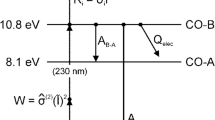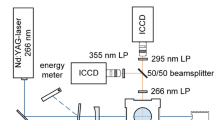Abstract
Within the underlying project, the task was to develop methods for optical measurements in a hydrogen-fuelled engine with direct-injection, with the goal of measuring the jet patterns during injection, the stratification of the charge at ignition point and the propagation of the flame during combustion. Therefore, the method of planar laser-induced-fluorescence (PLIF) was chosen. In order to apply this technique for the named tasks, particular methods the visualisation of fuel distribution and the flame front were developed. The measurements were carried out on a single cylinder research engine installed at the Institute for Internal Combustion Engines at Graz University of Technology. This engine features optical access through a quartz-glass liner and a window in the piston while providing a layout equivalent to modern passenger car engines and the possibility to operate in fired mode. As it is hardly feasible to directly excite molecular hydrogen by means of laser light, it is necessary to add a tracer substance to the fuel that provides high fluorescence intensity while not changing the properties of the fuel. Consequently, Triethylamine was chosen as a tracer to be mixed with hydrogen at 200 ppm, which allows it to be used up to a maximum pressure of 200 bar while still providing a strong LIF signal. Due to the excellent linearity of the signal to the local air/fuel-ratio it was possible to develop a method for the calibration of the images in order to compensate for inhomogeneities of the laser beam and staining of the optical access and to ultimately allow a quantification of the fuel distribution. The results are images scaled on air/fuel-ratio which can be used for a direct optimisation of mixture formation processes and the validation of CFD-models. For the analysis of the combustion process the method was adapted with two different approaches. For homogeneous charges a new method was applied by marking the flame front using the tracer within the fuel, so that both are burned together. However, as this method is limited to measurements with a homogeneous distribution of tracer within the measured volume, an alternative technique had to be applied for the measurement of stratified charges. In this case, a direct visualisation of the flame front was achieved by exciting the OH-radicals formed during combustion. As this method has significantly increased demands on measuring equipment and is more time consuming, both methods are used in parallel on specific measuring tasks.














Similar content being viewed by others
References
Andresen P, Meijer G, Schlüter H, Voges H, Koch A, Hentschel W, Oppermann W, Rothe E (1990) Fluorescence imaging inside an internal combustion engine using tunable excimer lasers. Appl Opt 29:2392–2404
Andresen P, Schlueter H, Wolff D, Voges H, Koch A, Hentschel W, Oppermann W, Rothe E (1992) Identification and imaging of OH (υ″ = 0) and O2 (υ″ = 6 or 7) in an automobile spark-ignition engine using a tunable KrF excimer laser. Appl Opt 31:7684–7689
Arnold A, Bombach R, Käppeli B, Schlegel A (1997) Quantitative measurements of OH concentration fields by two-dimensional laser-induced fluorescence. Appl Phys B 64:579–583
Blotevogel J, Egermann T, Goldlücke J, Leipertz A, Hartmann M, Schenk M, Berckmüller M (2003) Untersuchungen zur Gemischbildung in Wasserstoffmotoren. VI. Tagung Motorische Verbrennung, München, pp 77–88
Blotevogel J, Goldlücke J, Egermann J, Leipertz A, Hartmann M, Rottengruber H (2005) Untersuchungen zur Gemischbildung von Gasmotoren mit Hilfe laseroptischer Messverfahren. 10th Tagung Der Arbeitsprozess des Verbrennungsmotors, Graz, Vol I, pp 139–166
Chen Y-C, Mansour M (1999) Topology of turbulent premixed flame fronts resolved by simultaneous planar imaging of LIPF of OH radical and Rayleigh scattering. Exp Fluids 26:277–287
Fröba AP, Rabenstein F, Münch K-U, Leipertz A (1998) Mixture of Triethylamine (TEA) and Benzen as a new seeding material for the quantitative two-dimensional laser-induced fluorescence imaging of vapor and liquid fuel inside si engines. Combust Flame 112:199–209
Gerbig F, Strobl W, Eichlseder H, Wimmer A (2004) Potentials of the hydrogen combustion engine with innovative hydrogen-specific combustion processes. FISITA World Automotive Congress, Barcelona
Kirchweger W, Eichlseder H, Gerbig F, Gerke U (2003) Analyse von Wasserstoff-DI-Brennverfahren mit Sondermesstechnik. 10th Tagung Der Arbeitsprozess des Verbrennungsmotors, Graz, Vol II, pp 475–490
Kovac K, Wimmer A, Hallmannsegger M, Obieglo A (2005) Gemischbildung und Verbrennung im Wasserstoffmotor—Eine Herausforderung für die numerische Simulation. VII. Tagung Motorische Verbrennung, München
Nakamura Y, Manome S, Yamashita H (2006) Diagnostics of reactive zone in premixed flames via acetone-OH simultaneous PLIF. In: The13th international symposium on applications of laser techniques to fluid mechanics, Lisbon
Nasr A, Lai JCS (1997) Two parallel plane jets: mean flows and effects of acoustic excitation. Exp Fluids 22:251–260
Nasr A, Lai JCS (1998) A turbulent plane offset jet with small offset ratio. Exp Fluids 24:47–57
Reboux J, Puechberty D, Dionnet F (1994) A new approach of planar laser induced fluorescense applied to fuel/air ratio measurements in the compression stroke of a S.I. Engine. SAE-Paper 94188
Wallner T (2004) Entwicklung von Brennverfahrenskonzepten für einen PKW-Motor mit Wasserstoffbetrieb. Dissertation of TU Graz
Wimmer A, Wallner T, Ringler J, Gerbig F (2005) H2-direct injection—a highly promising combustion concept. SAE Paper Nr. 05P-117
Author information
Authors and Affiliations
Corresponding author
Rights and permissions
About this article
Cite this article
Kirchweger, W., Haslacher, R., Hallmannsegger, M. et al. Applications of the LIF method for the diagnostics of the combustion process of gas-IC-engines. Exp Fluids 43, 329–340 (2007). https://doi.org/10.1007/s00348-007-0287-1
Received:
Revised:
Accepted:
Published:
Issue Date:
DOI: https://doi.org/10.1007/s00348-007-0287-1




